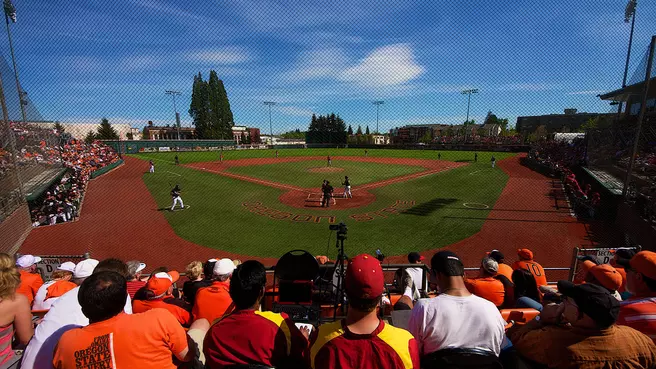Goss Stadium at Coleman Field

Built: 1907 (renovated 1999, 2009 and 2015)
Dimensions: 330-Left, 365-Left Center, 400-Center, 365-Right Center, 330-Right (8 feet fences, 14 feet in left field)
Seating capacity: 3,248
Oregon State All-Time record at Goss: 1,134-474-1 (.705)
Longest OSU win streak: 24 games (1951-52)
First Game: April 12, 1907 (Salem High 4, Oregon State 0)
First Night Game: April 26, 2002 (Oregon State 3, Stanford 1)
Goss Stadium at Coleman Field, which has stood on the Oregon State campus since 1907, is now the oldest continuous ballpark in the nation. The Beavers have played at the site of Goss Stadium since the program began play more than 100 years ago.
The stadium itself has undergone numerous changes - including multiple renovations and expansions - but the playing field itself has stood in place since day one.
And just like day one, Goss, formerly known just as Coleman Field, has hosted games in front of one of the best fanbases in the nation.
Goss saw its third renovation over the past 15 years prior to the 2015 season. A new home clubhouse was built down the left field line, forcing the Beavers’ bullpen to be moved beyond the fence in left field.
The new clubhouse gives the Beavers a new state-of-the art locker room; a new coach’s locker room and game-day coaching offices; a repurposed players lounge; a medical training area; a larger equipment room, a recruiting area and a hospitality deck. The hospitality deck will host “Banners” with a new concessions area that will pay homage to the team’s successful past with championships and dogpiles.
The addition to the stadium comes on the heels on one of the most fantastic seasons at home for OSU in its history. The Beavers went 24-6 at Goss in 2014, and set a school record for the highest average attendance (2,931) in a single season. That mark stood as the 19th best nationally and was tops on the West Coast.
That was the second consecutive season the Beavers set a new mark. In 2013, Oregon State fans poured through the turnstiles in then-record numbers as the Beavers averaged 2,676 per game, or just more than 82,000 overall.
And for good reason as Beaver Nation came to see one of the best seasons in school history.
The Beavers went 27-5 at Goss Stadium in 2013, tying a school record for most wins at home in a single season.
Oregon State is 1,134-474-1 at home since opening play in 1907, a winning percentage of .705. Since Goss’ 1999 renovation, the Beavers are an astounding 287-121 (.703).
The Beavers have utilized the home field advantage in the last 10 seasons, in which Oregon State has gone to Omaha four times. Since 2005, OSU is 214-63 (.773). In the four years it has gone to Omaha over that stretch, the Beavers are an incredible 97-21 (.822).
In 2012, the Beavers went 18-6 at home and averaged nearly 2,000 fans as the club posted its fifth 40-win season in school history.
That continued the trend of packing the park and watching the Beavers utilize Goss as one of the Pac-12 Conference’s toughest venues for opposing clubs.
The team hosted its fourth NCAA Regional in 2011, and the support the club received at its home diamond helped the Beavers to an NCAA Super Regional appearance.
Nearly 69,000 fans attended games at Goss Stadium in 2011, an average of 2,285 per, setting school records - at the time - for a single season. Oregon State went 23-7 at home, just the fifth time in program history the Beavers won 20 or more.
A project spearheaded by head coach Pat Casey expanded the stadium prior to the 2009 season and gave the ballpark a facelift. Nearly 1,000 seats were added down the left and right field lines, enabling more Oregon State fans to witness one of the top programs in the nation.
The seating addition is far from the only change fans saw beginning that year. A stadium suite, called the Omaha Room, looms over right field with seating for approximately 70. Modeled after the club level at football’s Reser Stadium, it can also be used for team banquets and other various events.
Underneath the Omaha Room are two rooms -- an academic room and a Hall of Fame room. The academic room and Hall of Fame area are utilized to celebrate the fine history at Oregon State and to allow its current student-athletes the chance to excel in the classroom.
Last, but certainly not least, is a player’s lounge located underneath the left field stands that gives Oregon State players the chance to relax before games and unwind afterwards.
The expansion completed a string of stadium upgrades as a video board located in right field was installed prior to the 2007 season. The board was the first of its kind in the then-Pacific-10 Conference and allows fans to watch replays and enjoy capabilities rivaled by Major League stadiums.
In each of the five seasons Oregon State has hosted a regional or super regional, each game, totaling 22 in all, surpassed the 2,000 mark in attendance. Also, the Beavers saw crowds of 3,000 or better in 21 of those 27 games.
Pat Casey, now in his 21st season at Oregon State, has especially taken advantage of Goss Stadium, using the fans’ passions and his team’s talents and turning them into wins. In his 20 previous seasons, Casey’s clubs have posted a 351-137 (.719) mark at home. In 2005, Oregon State set a program record with 26 home wins. A year later, the Beavers set the record again, finishing with 27 wins at venerable Goss Stadium.
Casey, just one four coaches in the past 60 years at Oregon State, has seen two of the most significant stages of Goss Stadium. Previous to the 2009 expansion, in 1999, the park, then known just as Coleman Field, saw a major renovation. That renovation brought improved seating areas, a new press box and improved locker rooms and dugouts.
Over the past 15 years, Goss Stadium saw other improvements. In the spring of 2002, lights were added to the ballpark, making night games a possibility. And prior to the 2007 season, a new scoreboard with video replay capabilities went up in right-center field. During that same period, the Beavers got a new playing surface in the infield as FieldTurf was installed. The outfield remains natural grass.
The stadium’s videoboard was the first of its kind in the Pacific-10 (now Pac-12) Conference. Located in right center field, it was a welcome addition to the historic ballpark. Fans have the opportunity to watch replays, catch game highlights from past Oregon State victories and keep abreast of play in other conference games. As one of the few teams in the nation with a videoboard, the Beavers have the ability to provide a true gameday experience.
The park has an interesting history, to say the least.
When Oregon State began fielding a varsity baseball team in 1907, the school laid out a diamond on a lot just south of the main campus. A century later, that same site still serves as the home of the Beavers, making Goss Stadium at Coleman Field the oldest diamond in the Pac-12 Conference and the oldest college fields in the country.
Over the past century, the campus has grown around Goss Stadium at Coleman Field, making it one of the most picturesque settings in college baseball. The ballpark is a short walk down Waldo Place from the Memorial Union and OSU’s central campus area, making it easy for students to stop by a game between classes.
The field is named for former Oregon State player and coach Ralph Coleman, who guided the Beavers for 35 seasons from 1923-66. The stadium is named for John and Eline Goss, whose major lead gift to the $2.3-million fundraising effort made the project possible.
John Goss was an Oregon State track and field letterman in the 1930s. The naming of the stadium is also a memorial to his older brother, James Goss, an Oregon State graduate.
The Goss family made additional contributions to OSU toward endowed scholarships for student/athletes and other top academic students, including graduates of Portland’s Grant High and members of the Beta Theta Pi fraternity.
The park is symmetrical, measuring 330 feet down the foul lines, 365 to the power alleys and 400 to center. The fence is 14 feet high from left field to left-center, then eight feet high from left-center to right field.
The concrete, steel and brick structure has a press box, a lobby/concession area, restrooms, locker rooms, dugouts and storage areas. The stadium was designed to complement the architecture of the surrounding campus, and to evoke the aura of baseball’s historic parks.
The first game after the addition of Goss Stadium to Coleman Field was on March 12, 1999, when defending national champion Southern California topped the Beavers 5-2. The stadium was dedicated on April 17, 1999 as OSU beat California 11-5 before a crowd of 1,246 and a national cable television audience.
The ballpark saw its first night game on April 26, 2002, as the Beavers beat fourth-ranked Stanford 3-1. A set of lights meeting professional Class Triple-A standards was installed that spring thanks to the generosity of longtime OSU boosters Bert and Shirley Babb.
Goss Stadium at Coleman Field has batting cages behind the left-field fence. When conditions call for indoor practice, the Beavers head for OSU’s Truax Indoor Practice Facility, which opened in August, 2001. The team’s players can also head to the McAlexander Fieldhouse, which was renovated in 2011 to provide the Beavers with two new batting cages that are available year-round. The Fieldhouse is located across a small parking lot beyond left field.
The addition of Goss Stadium to Coleman Field ended years of speculation over whether the Beavers would be able to remain playing baseball at their longtime home.
As Oregon State expanded, land near the center of campus became scarce and the school’s master plan called for the site to eventually be turned over to academic uses.
In 1961, The Oregonian newspaper noted: “In the not-too-distant future, Oregon State baseball hopefuls won’t have railroad tracks as a long-distance batting target. Coleman Field will eventually hold no basepaths, only buildings in this era of construction for higher education. Already one classroom building for this site is beyond the drawing board stage.”
For over 30 years, that possibility prevented any major improvements to Coleman Field. Long-term plans for the OSU campus called for moving the baseball field southeast of the intersection of Western Boulevard and 26th Street.
In 1996, the baseball program explored building a press box and storage/concession building at Coleman Field. The possibility of building a stadium was also looked into, and that gradually became the goal of the baseball program and many Beaver boosters.
The generous donation from the Goss family was the key to a private fundraising effort in the late 1990s. The ballpark’s name was ammended to Goss Stadium at Coleman Field in their honor in 1999.











